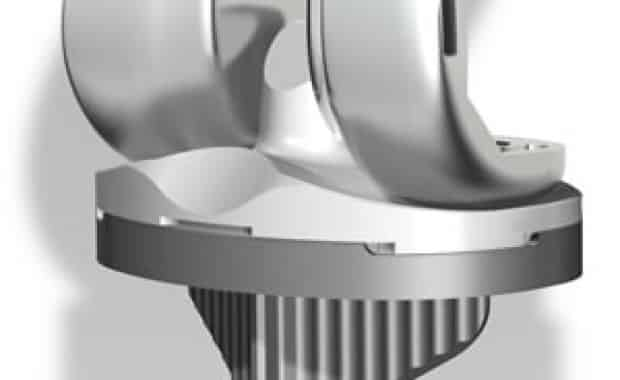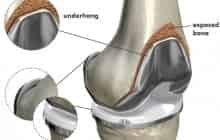
Although a number of factors contribute to joint disease including genetics, developmental abnormalities, repetitive injuries and obesity, arthritis is the most common reason for knee implant surgery. A diagnosis of advanced osteoarthritis of the knee will indicate the need for total knee replacement implants. Arthritis limited to a single compartment of the joint may require only a partial knee implant.
The knee has three compartments: an inside (medial), outside (lateral), and a front (patellar) compartment for the kneecap. Generally, a unicompartmental (or partial) knee arthroplasty is performed when only one compartment is affected by arthritis, and total knee arthroplasty is performed when 2 or 3 compartments are affected.
Total Knee Implant Components
In a total knee replacement, each compartment of your diseased knee joint will be replaced with man-made components or implants, eliminating the damaged bearing surfaces that are causing pain. A diagnosis of advanced osteoarthritis of the knee will indicate the need for total replacement of the knee joint.
There are three implant components to a knee total replacement: femoral, tibial and patellar. They are designed such that a metal component always moves against plastic or other synthetic material. This promotes smooth movement and minimal future wear.
Femoral Component: In a knee implant, the femoral component made of metal, curves up around the end of the femur (or thighbone). It has a central groove allowing the patella (or kneecap) to move up and down smoothly as the knee joint bends and straightens.
Tibial Component: The tibial component of a knee implant is a flat metal platform with a polyethylene insert or spacer. These have a double dish configuration for the femoral condyles, and either a notch to accommodate the cruciate ligaments (cruciate sparing) or a cam structure to take its place (cruciate sacrificing).
Patellar Component: The patellar ‘button’ is a dome-shaped piece of ultrahigh molecular weight polyethylene that replicates the surface of the kneecap.
More about Total Knee Implants >>
Partial Knee Implant Components
All three compartments of the Knee (medial, lateral, and patellar) can each be resurfaced without interfering with the rest of the joint. These implants are usually referred to as unicondylar meaning one condyle:
- medial unicondylar implants that go on the inner side of the joint
- lateral unicondylar implants that go on the outer side of the joint
- femoro-patellar implants that go between the femoral condyles where the patella (knee cap) sits (The patella will be resurfaced as well.)
A partial knee replacement involves a smaller knee implant for one, two or all three compartments, rather than for the entire knee joint. The advantage of a partial knee implant is that only the damaged cartilage and bone from the weight bearing portion of the femur is removed. They are resurfaced with a cobalt chrome implants that conforms precisely to the anatomy of the knee. The tibial component can be made of polyethylene only, or may contain polyethylene in a metal tray. Either way, they both require only minimal bone removal to secure the implant.

iDuo® Bicompartmental Knee Implant (ConforMIS)
If two compartments are compromised, and a total joint replacement is not required or desired, you may have the option of a bi-compartmental knee implant. Bicompartmental knee replacement replaces only the medial compartment and patellar compartment. It does not re-surface the outside (lateral) part of the knee and allows for the anterior cruciate ligament (ACL) and posterior cruciate ligament to be retained. Such implants can be custom made for the knee replacement patient from MRI scans.
Based upon your specific arthritic condition, your age and lifestyle, there are several design options to choose from that will help you return to an active, enjoyable life. Ultimately, your knee surgeon will make a knee implant recommendation (both design and brand) based upon his or her skill and experience with a particular device as well as your specific circumstances and needs. It is, however, important to understand the differences between implants so that you can engage intelligently with your surgeon on the subject.
More about Partial Knee Implants >>
Filed Under: Knee ReplacementKnee Implants





